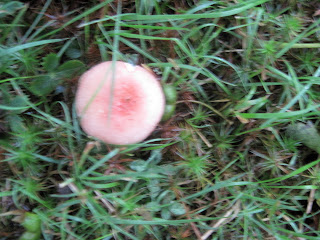
It's the new after-storm sport! After a lot of rain – be it rain storm, tropical storm, or hurricane– come the mushrooms. Make a family activity of it and bring your camera. Go in the back yard, in the woods or a field, and keep your gaze low to the ground. (Mushrooms also grow on dead and dying trees, of course, but it's the ground-dwellers that appear out of nowhere that we look for now. Call it "gnome-hunting" if you want.)
This activity serves three purposes: Time with the family (that doesn't require electricity aside from the batteries in your camera and flashlight), exercise, and learning to identify mushrooms. Most mushrooms are poisonous and your first foray into their unknown world should be cautious and respectful. Don't touch mushrooms with bare hands or taste them. Wear long pants. Bring insect repellent. (Lavender and feverfew are natural insect repellents and can be rubbed on clothing and hair. Never use insect repellent with deet on pets or small children. Do not use feverfew or pyrethrin-containing products on cats.) Take lots of pictures and note when (month) and where (log, ground, field, sun, shade, etc.) you found the mushroom. Note stem and cap sizes, gills, spore color, or other distinctive characteristics. Bring a flashlight if you're in a dark area.
I am by far NOT an expert in mushrooms, but I am starting to learn about edible ones. I have one accessible mushroom I believe to be an edible bolete that right now I am just watching. Misidentification can lead to severe illness and death. Do not eat wild mushrooms unless you have a positive identification from a trained guide (mycologist), the mushroom is not spoiled, and the mushroom has been cooked! One Asian family, gathering mushrooms in the U.S. that looked like the edible ones from their homeland, all died. Another family in Mexico bought wild mushrooms at a Farmer's Market that were misidentified and also died. Alcohol intensifies the effects of toxins. Then there's simple allergy. I don't mean to scare people, but foraging of this sort should not be taken lightly. For help with identification and symptoms of poisoning, check here. It's fun just finding mushrooms and trying to identify them.
Now, the modest (and growing) gallery:
 |
| The rare rubber interior of a tennis ball. For dogs only! |
 |
| Lepiota cepistipes? |
 |
| Amanita? |
 |
Scutellinia umbrarum? |
 |
Cortinarius? |
 |
| Indian Pipe. (Monotropa uniflora) Not a mushroom but a plant. Lack of chlorophyl contributes to its white color. It is parasitic rather than photosynthetic. |
 |
Agrocybe acericola? |
 |
Laxitextum bicolor? |
 |
| Boletes? |
 |
| Possibly Boletus impolitus or Boletus edulis I'm watching you! |
 |
| Same mushroom two days later. |
 |
| And again. |
And finally, a recipe with mushrooms:
Vegan Option/Wild Option
________________________________________________
Cacciatore Catch-All
Taste of Italy
________________________________________________
Prep: 15 minutes Cook: 45 minutes Serves 4
2 lbs. local chicken parts (optional)
2 tbs. olive oil
1/2 red onion, diced
1 red or green bell pepper, coarsely chopped
4 cloves garlic, minced
2 cups peeled tomatoes* (Roma and/or cherry)
2 cups sliced wild puffball mushrooms** (or white button or baby bella)
1 cup of “catch-all”: washed and chopped zucchini, summer
squash, or what-have-you (optional)
1 tbs. dried oregano (or 2 tbs. fresh)
1/2 tsp. salt
1/4 tsp. white pepper
1/2 cup red wine (from freezer cubes?)
“Cacciatore” means hunter in Italian and often features wild mushrooms** (assuming the hunter did not want to come home empty-handed). This recipe is a great way to use up odds and ends from canning. Consider measurement of vegetables approximate. Leftovers can even be added to an omelet, frittata, or soup.
Heat olive oil on medium-high in Dutch oven or large skillet with cover. If using chicken, brown meat five minutes each side and set aside. Add onions, garlic, and bell pepper to pan. Cook two minutes, or until onions soften. Add tomatoes, mushrooms, and remaining vegetables. Season with salt, pepper, and oregano. Add wine and bring to boil. Reduce heat to simmer. Add chicken and cover. Cook 30 minutes, or until chicken reaches 165ºF and vegetables are soft. Serve with crusty bread, pasta, or rice.
* When canning tomatoes, skins are removed by blanching. This is done by dropping whole tomatoes in boiling water about one minute, then into ice water one minute, to easily peel skin. I’ve used the leftover seeds and juice from canning harissa sauce with plum tomatoes. You could also use already canned tomatoes or just chop fresh tomatoes and leave skins on.
** Do not attempt to gather wild mushrooms without a certified guide. Puffballs (Calvatia gigantea) should be the size of two fists or larger and white throughout. Discolored puffballs are not safe to eat and will not taste good. Immature amanita can be mistaken for puffballs, thus the need to look for larger mushrooms. (Puffballs can grow quite large and have even been mistaken for Styrofoam trash in littered woodlands!) Cutting the mushroom may reveal more: A “U” shape indicates the immature cap of the poisonous amanita, but may not always be visible. Alcohol intensifies reaction to any poisonous mushroom. Don’t risk it!!! The author and publisher assume no liability for injury, poisoning, illness, or death from consuming wild mushrooms or plants. Leave it to the experts: Puffballs may be available at some farmers’ markets or high-end food stores.




























